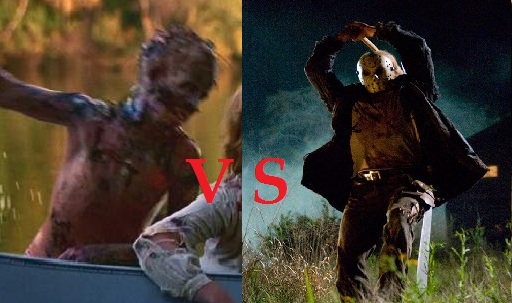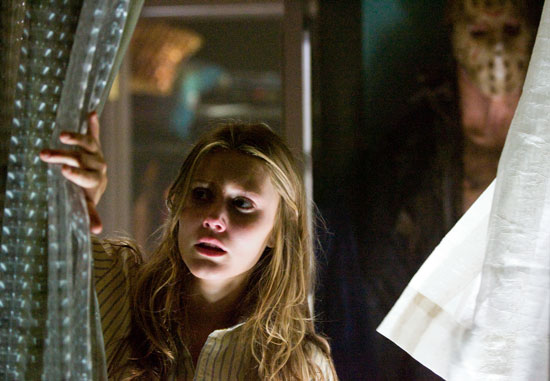Remakes are nothing new. From the silent era onward, filmmakers have returned again and again to the same stories, re-interpreting them and updating them either for the sake of modernization, to expose them to a broader audience or to just make more money. We modern film geeks tend to roll our eyes and groan cynically when a new remake comes down the pike, but the fact of the matter is that when done right there are few things as satisfying as a seeing a story we love get a good cinematic spit-shine. Remakes are a part of the grand tradition of storytelling and cinema history, and love them or hate them, they’re here to stay.
But in the last decade, the term “remake” has become something of a dirty word, and as a result Hollywood spin doctors and internet journalists have given us the new terms “reboot” and “re-imagining”. Do these terms actually have meaning, or are they just empty buzzwords? The mission statement of this ongoing column will be to answer that question by comparing an original film to a re-do and determining if the newer version fits one of the following definitions:
Remake: A straight re-telling of a story for the purpose of updating it for a contemporary audience, or making it accessible to a different culture or region.
Reboot: A course correction done with the purpose of restarting a franchise. A reset. Fealty to the original story or film is not a priority.
Re-Imagining: A re-telling of a story, but only in the broadest sense. Characters and some story elements may be retained, but mostly plot and story have been repurposed.
I also will make a judgment call on which version is superior. Some controversy may ensue.

FRIDAY THE 13TH (1980) VS. FRIDAY THE 13TH (2009)
The story: Nubile teenagers are stalked by a killer at an abandoned summer camp.
What’s the deal?: The deal is, these two movies are not at all the same. Aside from the broadest of strokes and a brief opening scene which plays as a Cliff Notes of the final scene of the 1980 film, Marcus Nispel’s Friday the 13th does not follow the story of Sean S. Cunningham’s Friday the 13th. Comparing the two films side-by-side in terms of plot is a worthless endeavor. But the one point of comparison that stuck out to me so strongly upon recent re-watching was intent, and I would argue that in terms of intent, Friday the 13th 1980 and Friday the 13th 2009 are almost the same movie.
I’m gonna be honest here – I do not hold the original Friday the 13th as some kind of classic of horror cinema. Aside from the remarkable kills, the movie just doesn’t do much for me. Where some people see suspense, I see a ploddingly slow and largely dull riff on something John Carpenter did a million times better in Halloween. The acting is mostly poor, the mystery is a cheat and aside from the slightly scummy and appealing grindhouse quality, the film isn’t particularly striking in its look or design. What it is most loved for is its place at the head of a beloved horror franchise, a franchise that would make an icon of a killer that doesn’t even show up in this film until the very end. Removed of nostalgia and historical importance, Sean S. Cunningham’s Friday the 13th is best remembered for the great kills by gore maestro Tom Savini, and that magnificent and still startling end dream sequence, also the work of Savini. As an early 80’s slasher movie it’s pretty decent and worthy of its place in the pantheon, but as a movie on the whole I don’t find much in it that I can’t find in other better films, and even other Friday the 13th films. It is not a film that I find myself wanting to revisit with any real frequency.
But I’m not going to begrudge anyone their love of the original Friday the 13th; we horror fans have our cherished favorites and the actual quality of the work itself usually isn’t a major factor. But one thing about Friday the 13th that seems to have been largely obscured by time and nostalgia is what a cynical cash-grab of a film it was. This was a movie that was sold as a title before it was ever even a script! You don’t get any more cynical than that. It was a cash-in on the aforementioned Halloween and cemented the early 80’s trend of slasher films based on significant calendar days. You might regard Friday the 13th 1980 as some noble work of art, but I have to tell you that if you think that, you are weird and possibly delusional. Friday the 13th 1980 is a big piece of crap. It may be a big piece of crap that you love and that entertains you with its Kevin Bacon death by arrowhead and generous amounts of onscreen camel-toe, but it was, is and always be a big piece of crap.
And guess what? Marcus Nispel’s 2009 Friday the 13th is also a big, cynical piece of crap! Like the original, this film exists mostly as a cash-in; the difference being that this time the cash-in is on the Friday the 13th brand name and its value as a money-making franchise. The producers of the 2009 film wisely understood that the value in the franchise was not in the original film’s story, but in the iconic hockey-masked killer Jason, a character that didn’t really get established until the sequels of the original film. So the story of the remake cuts right to the chase of Jason being the killer, hatin’ on partying, sex-hungry teens left and right. I wouldn’t argue that it’s necessarily a better story than the 1980 film, but as there would be absolutely no point in retelling that mediocre whodunit again, it’s a choice that makes sense considering today’s more plot-savvy audiences.
Thus far it seems like I’m really down on both Friday the 13ths, but honestly I’m not. I love all the Friday the 13th films, warts and all. But aside from a few highlights like Friday the 13th Part 4 the Final Chapter (a film the 2009 F13 borrows from most in terms of story) I see them as roughly the same in terms of quality, and that quality is junk food horror. It’s good junk food, like Popeye’s Chicken or In and Out Burger, but it’s junk food regardless. The entire film series exists for one purpose and one purpose only and that is to generate money. So as far as the series’ “integrity” goes, it never had any, so it never bothered me in the slightest that it was being given a re-do. In fact, it seemed inevitable considering the remake boom of the oughts. And hell, if it got my murderous and mentally challenged pal Jason Voorhees back on cinema screens, I was all for it.
I’m not going to sit here and tell you that Marcus Nispel’s Friday the 13th is a great horror film. It’s not. It’s loud, ungraceful, largely soulless and mediocre in execution, especially in the all-important kills department. But I’d be lying if I said that I don’t like it. It has one of my favorite Jasons thanks to the committed performance of Derek Mears. (Nerd digression: My two favorite Jasons are Mears and Ken Kirzinger from Freddy vs. Jason. They’re tied because Mears is clearly human Jason, and Krizinger is clearly zombie Jason. I know it is sacrilege but I hate Kane Hodders huffing supposedly “definitive” Jason.) It has the required nudity and gore, and I actually find the performances of the kids to be good as far as this sort of thing goes. And one thing the movie has that is rarely mentioned is that it has a decent sense of humor. The character of Trent is hilarious and an obvious send-up of countless teen slasher movie douchebags and the better of the kills have a sick humor to them, like the ‘through the dock impaling and subsequent boob reveal’ shot. There is entertainment value to be had in Friday the 13th 2009, which is something you can’t say about most of the horror remakes. I personally feel that when counted against its remake brethren and the franchise as a whole, it’s a pretty solid entry.
So as far as shameless cash-grabs are concerned, I don’t feel that Friday the 13th 2009 is particularly egregious. But the shameless cash-grab element is definitely the deciding factor in determining its remake, reboot or re-imagining label. It is certainly not a remake as it does not follow the original’s story other than that there are teens, a camp, and killing. It’s not a re-imaging either because outside of Jason and the brief flashback of Mama Voorhees, none of the characters are the same. The main purpose of the film is to reset the idea of Friday the 13th for a new audience, so in that sense it is purely a reboot. I don’t know how successful it was at achieving this as a sequel has yet to be announced. But chances are that if there are teenagers out there who know the name Jason Voorhees, it’s probably this film, or 2003’s Freddy vs. Jason, we have to thank.
Verdict: Reboot

Which is better?: OK, here’s where I’m going to get in trouble. I will not in good conscience say that Friday the 13th 2009 is a better film than Friday the 13th 1980. For all its flaws (and really, c’mon guys, there are lots) the original has a place in history thanks in no small part to Tom Savini, and the reboot will never have that honor. The reboot is a disposable foot note to the franchise (unless it remains the last film in the franchise, then it will be significant), a franchise that wouldn’t exist in the first place were it not for the original. But – and this is a big But – I personally enjoy watching the reboot more than watching the original. Sure, it doesn’t have a great score like the original does. (Why the hell didn’t they get Harry Manfredini back to score the reboot?! It would have added so much in the way of improvement.) Sure the kills aren’t on par with some of the series’ best. Sure it is slick and soulless. But it has a great Jason, and call me a fanboy, but when I want to watch a Friday the 13th movie, I want to see a hockey-masked maniac fucking shit up first and foremost. Really when I want to watch a F13 movie I’ll put in Part 4, but I find the reboot fun and it gets the occasional face-time on my Blu Ray player. It doesn’t carry the weight of the original, but I find it more enjoyable on a personal level, so I have to call this one a tie. Please don’t hack me up with a machete.
Up Next: The Thing